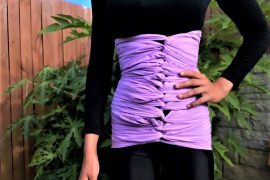“Which belly wrap should I use?”
I have seen multiple easy-to-use versions of the traditional Bengkung Belly Wrap popping up on places like Etsy, Amazon, and Prenatal retailers. Most of these wraps are either a compression band by design or an adjustable postnatal-friendly corset. After binding hundreds of bellies, I have parted with my traditional Bengkung Belly Bind, too. Not without heartache. I am in love with how the traditional belly bind adorns the birth body, giving her the love, beauty, and recognition she deserves. I also think it’s a special token that takes you from pregnancy through labour and postnatal healing, as it can be used for prenatal belly support, a shawl to rock the hips with during labour, and for postural support postpartum. And the best thing is that it can be bound in many ways, allowing for customisation. Those who are inspired by traditional binding, can still drop me an e-mail to have their wrap made-to-order with deadstock fabrics – giving preloved designer fabrics a second life. But, for those who are after all the benefits but prefer a quick and easy bind, I added a super easy wrap-around style binder to the Heavenly Postnatal Package, that gives you all you need for the first six weeks at just £4.17 a day.
Two important things to note:
- always activate your pelvic floor before you start binding.
- always bind from the hips up. Binding from the lungs down will put downward pressure on your lower abdomen, which pushes your uterus down. Not exactly what you’d like while she is repositioning and toning after birth.

What foods should I favour in the Fourth Trimester?
The Maharishi tradition teaches us that there’s a need to apply the ‘Universal Mother Principles’ to your postnatal dishes. This means that the food has to be: nutrient-dense, easy to digest, and beautiful. Grains like quinoa, wild rice or amaranth cooked in bone broth, slow-cooked porridge made with cashew milk and saffron, or spiced stewed apples for breakfast all tick those boxes. The Ayurvedic tradition also teaches that to balance the Doshas (your body’s energetic profile) you need to work with the Sweet taste, as this helps expel excess air and ground the nervous system. Additionally, your gut needs spices to kindle the digestive fire. The digestive fire is reflected in each and every body cell and is the key to radiance and rejuvenation. Black Pepper, Cardamom, fresh Ginger, Cinnamon, a dash of Nutmeg, and vanilla pods are all helpful. Prebiotics are important, too, so try to include a diverse selection of veggies in your diet. Remember to spice and cook them thoroughly and add a gallop of Ghee to aid in digestion. Raw veggies are on Ayurveda’s blacklist postpartum as they may cause gas. A digital copy of Ayurveda Mamma’s comprehensive postnatal nutrition guide is included in the Heavenly Postnatal Package.

“I am pressed for time. Which self-care tools should I prioritise?”
For busy mums, an Ayurvedic Doula can pack your weekly treatments with all your essential self-care, from nutrition advice, to herbal medicine, abdominal toning, nervous system resets, and perineal healing. If this well-rounded support is something you’re after, make sure to look out for a Doula who is also a certified Ayurvedic Practitioner or Vaidya.
If it’s not an option to work with an Ayurvedic Doula, I would personally dedicate time to plan my meals ahead. Precooked and frozen, delivered from a restaurant or local caterer you trust (I recommend having a chat. Especially Indian restaurants are often open to altering the dishes to the needs of a new mother), or cooked following the postnatal nutrition planner by a family member. Once you’ve got that covered, get your daily self-massage in and don’t forget to take your Lactation T’ and Drowsy Drops when your breaths are shallow and you need a break. My best-kept secret is that Ayurveda Mamma’s Abhyanga Oil comes with a tailored self-massage strategy when you opt-in for personalisation. Or you can do your own research on Abhyanga and Marma Points by doing a deep dive in Dr. Vasant Lad’s work. I recommend!
Visit the Ayurveda Mamma website to find out more, and follow Deborah on Facebook and Instagram.










